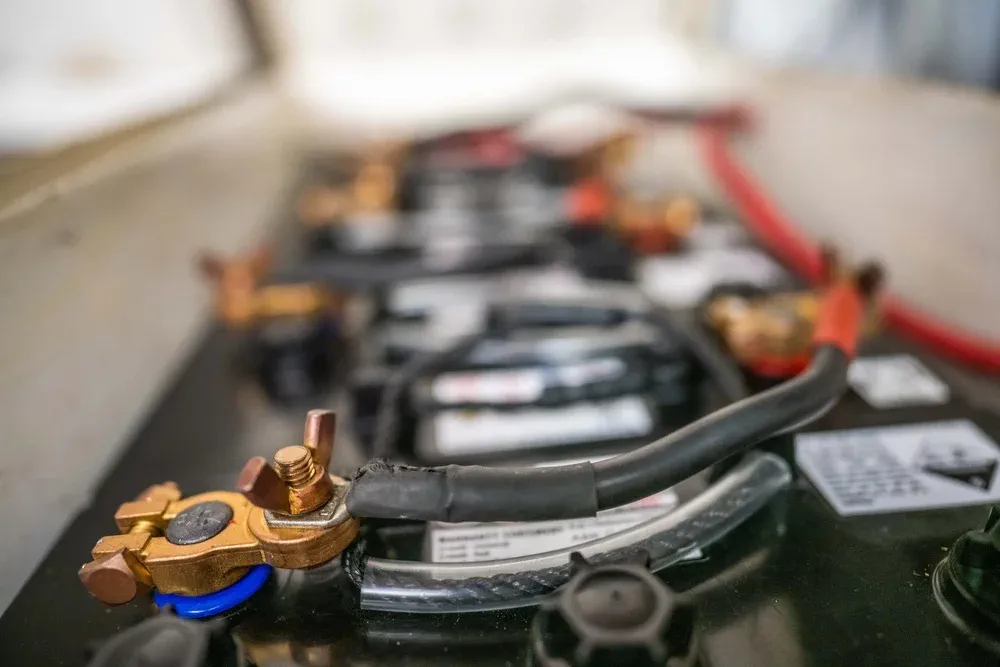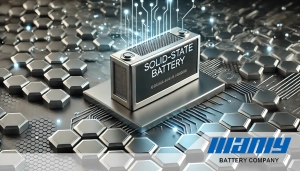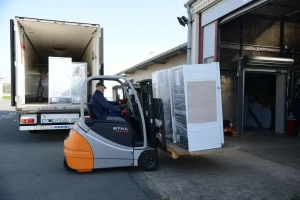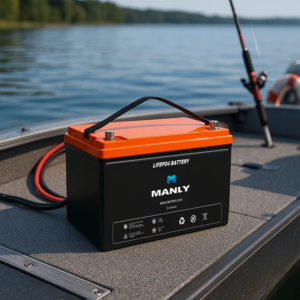2024 Marine Battery Guide: Types, Use, & Maintenance
Table of Contents
- 2024 Marine Battery Guide: Types, Use, & Maintenance
- Exploring Types of Marine Batteries: Basic Difference
- A Guide to Types of Marine Battery: Differences of Chemistries
- Expert Insights into Marine Battery Ratings and Their Importance
- Essential Marine Battery Maintenance Tips
- A Step-by-Step Guide to Replacing Your Boat's Battery
- Expert Guide to Charging Your Marine Battery Effectively
- Choosing the Right MANLY Battery for Your Marine Adventures
- Learn More About Battery

Exploring Types of Marine Batteries: Basic Difference
Marine batteries are crucial for powering various functions on your boat. These batteries come in different types, each tailored for specific needs and applications. Let's explore the most common types: starting batteries, deep cycle batteries, and dual-purpose batteries.Starting Batteries: Powering Your Boat's Engine
Starting batteries are like sprinters; they deliver a quick, high-power burst to start your boat's engine. They achieve this through a unique construction of numerous thin plates, providing a large surface area for a short, high amperage output. However, they have two main limitations: their fragile nature in high-impact environments and a lower tolerance for deep discharges.Deep Cycle Batteries: The Marathon Runners
In contrast, deep cycle batteries are the marathon runners. They are designed to provide a steady power output over longer periods, ideal for running the boat's electrical loads when charging sources aren't available. Their thicker plates with high antimony content allow them to recover fully after being deeply discharged. Typically, these batteries are used to power things like lights, GPS, and other electronics on your boat.Dual-Purpose Batteries: The Versatile Choice
For those needing a balance between starting and deep cycle batteries, dual-purpose batteries are the solution. They can handle deep discharges better than starting batteries and have a higher storage capacity than deep cycle batteries. This makes them suitable for small powerboats and sailboats where space for multiple batteries is limited.A Guide to Types of Marine Battery: Differences of Chemistries
Marine batteries are the unseen heroes of the boating world, powering everything from engines to electronics. Understanding the various types available is crucial for every boat owner.Lead Acid Batteries: Traditional but Bulky
Lead acid batteries, particularly the Flooded Lead Acid (FLA) type, require regular maintenance such as adding water. Despite their lower cost, they need frequent replacement, usually every 2 to 4 years, which can be inconvenient and costly in the long run.Marine Gel Batteries
Marine gel batteries, a specialized type of battery, are increasingly becoming the go-to choice for boaters due to their numerous advantages over traditional flooded and AGM batteries. They use a gelled electrolyte instead of a liquid, making them a safer and more reliable power source for marine applications.Advantages of Marine Gel Batteries
- Low Self-Discharge Rate: Gel batteries stand out with a self-discharge rate of only three percent per month. This feature is particularly beneficial for boats that are not used daily, reducing the frequency of recharging.
- Long Life and Durability: They can handle a high number of charging cycles over their lifetime, offering exceptional durability. This makes them a cost-effective choice in the long run, despite their higher initial cost.
- Maintenance-Free and Safe: One of the key benefits of gel batteries is that they are maintenance-free. They do not require topping up with water, reducing the effort and time spent on upkeep. Additionally, their sealed design makes them spill-proof and leak-proof, enhancing safety on your boat.
- Resistant to Rough Conditions: The robust construction of gel batteries makes them resistant to vibration and less likely to spill acid. This feature is crucial in a marine environment where movement and jostling are common.
- High Energy Density: Gel batteries are known for their high energy density, meaning they can store a significant amount of power. This makes them ideal for powering various electronics and equipment on your boat.
- Cost Factor: They are generally more expensive than both flooded and AGM batteries. However, their long lifespan and reliability can justify the investment.
- Charging Requirements: Gel batteries need carefully regulated smart charging to prevent damage. It's important to use the correct charger and follow proper charging procedures.
Marine AGM Batteries: Modern Alternatives
As boating enthusiasts seek improved performance, many are turning to Absorbed Glass Mat (AGM) batteries. These batteries represent a significant advancement over traditional flooded batteries, offering several key benefits that cater to the unique needs of marine applications.What Makes AGM Batteries Special?AGM batteries are known for their unique construction. They contain fine, highly porous microfiber glass separators squeezed between the battery's positive and negative plates. These separators are soaked in just enough acid electrolyte to trigger battery activation. This design is a game-changer because it minimizes the potential for spillage and leakage, making AGM batteries spill-proof, leak-proof, and even submersible.Key Advantages of Marine AGM Batteries- Maintenance-Free: AGM batteries do not require regular topping up with water, making them virtually maintenance-free.
- Improved Charging and Power: They accept greater charge currents, allowing them to be used as starter batteries if needed. The ability to accept up to 40% of their capacity in charge means quicker recharging times.
- Vibration Resistance: These batteries are more resistant to vibration, an essential feature in the often rough marine environment.
- Safety Features: AGM batteries are sealed and have pressure relief valves to release excess pressure, ensuring safety. Despite being sealed, they still need good ventilation to operate optimally.
- Efficient Performance: With only a 3% discharge rate, AGM batteries are efficient and reliable. They are suitable for dual purposes – both for quick starting power and for sustaining reliable deep cycle ability.
- AGM batteries require a smart charger and are sensitive to overcharging. It's crucial to maintain the charging voltage below 14.4 volts.
- They have a shorter life cycle in deep cycle applications compared to Gel or Flooded batteries.
- Improper charging can significantly reduce their lifespan.
Flooded Batteries: Economical but High-Maintenance
Flooded batteries are less expensive than AGM or gel types but require more maintenance. They are not sealed, meaning they need to be kept upright and in ventilated areas due to the gases they emit during charging. Despite their lower initial cost, they might not be the best choice for boaters looking for ease of use and low maintenance.Advantages of Regular Battery MaintenanceRegular maintenance of your marine battery has several benefits:- It can be more cost-effective than buying new batteries frequently.
- Well-maintained batteries have a longer lifespan.
- Properly cared for, marine batteries are 98% recyclable, making them environmentally friendly.
- They are readily available and easy to purchase globally.
- The battery must remain upright to prevent acid spills.
- They require adequate ventilation to function safely.
- Regular topping up with distilled water is necessary for optimal performance.
- These batteries should not be installed near sensitive electronics due to potential risks.
Lithium Iron Phosphate (LiFePO4): The Modern Marvel
In the world of marine batteries, the introduction of Lithium Iron Phosphate (LiFePO4) technology marks a significant leap forward. These advanced batteries, like the MANLY Lithium Iron Phosphate series, are redefining what boaters can expect from their power sources.Lightweight and Long-Lasting PowerLithium Iron Phosphate batteries, known for their compact and lightweight design, offer an impressive advantage over traditional marine batteries. They weigh less than half compared to their lead acid, gel, or AGM counterparts. This reduced weight means your boat can carry less weight, translating to better fuel efficiency and easier handling.Enhanced Capacity and Charging EfficiencyAnother standout feature of these batteries is their capacity and charging efficiency. Unlike older battery types that should only be discharged down to 50% of their capacity, Lithium Iron Phosphate batteries can safely discharge up to 80%, providing 60% more usable power. This feature is crucial for long boating trips, ensuring that your trolling motor, lights, and navigation systems keep running efficiently.Unparalleled Durability and Maintenance-Free OperationDurability is another area where Lithium Iron Phosphate batteries excel. They can endure up to 3,500 discharge/charge cycles, dwarfing the 500 cycles offered by traditional AGM batteries. This longevity makes them a cost-effective choice in the long run, despite their higher upfront cost. Plus, they require no maintenance, freeing you to focus more on enjoying your time on the water.Dual Purpose and Smart Technology IntegrationA notable aspect of the MANLY Lithium Iron Phosphate batteries is their dual-purpose functionality. They are capable of starting your boat's engine and powering onboard electronics. Additionally, they come equipped with Bluetooth capabilities, allowing you to monitor the charge status directly from your smartphone – a convenient feature for the modern boater.Choosing the Right Battery for Your BoatWhen selecting a marine battery, consider your boating style and power needs. For heavy-duty engine starting, a robust lead acid or AGM battery might be ideal. For extended trips with high power demands, LiFePO4 batteries offer reliability and efficiency. Remember, the right choice ensures a smoother and more enjoyable boating experience.
Expert Insights into Marine Battery Ratings and Their Importance
When it comes to selecting the right marine battery for your boat, understanding battery ratings is crucial. These ratings give you a clear picture of the battery's capabilities and help ensure you choose a battery that meets your boating needs.Starting Battery Power: CCA and MCA ExplainedThe power of a starting battery is measured in two main ways: Cold Cranking Amps (CCA) and Marine Cranking Amps (MCA). CCA refers to the number of amps a battery can deliver for 30 seconds at 0°F while keeping the voltage above 7.2 volts. MCA, on the other hand, is measured at a warmer temperature of 32°F. Typically, MCA ratings are 20–25% higher than CCA because batteries perform better in warmer conditions.Reserve Capacity: Sustaining Power Over TimeAnother key rating is the Reserve Minutes, which indicates how long a battery can maintain a load of 25 amps before its voltage drops to 10.5 volts. For instance, a battery with a 150-minute rating can handle a 25A load for about 2 1/2 hours at 80°F. Since starting batteries are not designed for prolonged loads, the reserve minute rating is less critical for them than for deep cycle batteries.Sizing Your Battery: Matching Engine and Temperature NeedsThe size of the battery you need depends on several factors, including your engine size, type, and the ambient temperature. Larger batteries with higher cranking power are essential for colder temperatures, diesel engines, or large gas engines. Always aim to meet or exceed the minimum CCA recommended by your engine or boat manufacturer.Deep Cycle Functions: Understanding Amp-Hours and Reserve MinutesDeep cycle batteries are rated in Amp-hours (Ah) and Reserve Minutes. Amp-hours measure the total energy a battery can deliver over 20 hours before the voltage drops to 10.5 volts. For example, a 200Ah battery can run a 10A load for 20 hours. Just like with starting batteries, the reserve minute rating for deep cycle batteries indicates the duration a battery can maintain a 25A load. Amp-hours is generally a more relevant measurement for deep cycle batteries, which power house loads on a boat.Longevity and Cycle Life: Measuring Battery DurabilityBattery longevity is measured by cycle life, which indicates how many discharge cycles a battery can endure before it can no longer hold half of its rated capacity. This metric is crucial for differentiating deep cycle batteries from starting batteries, as the former can withstand numerous deep discharges, whereas the latter cannot.Essential Marine Battery Maintenance Tips
Securing and Maintaining Your Marine BatteryFor a smooth sailing experience, taking good care of your marine battery is crucial. This guide provides essential tips to help you maintain your marine batteries, ensuring they are always ready for your next adventure.Proper Battery Installation and SecuringFirst and foremost, it's important to securely install your marine battery. Use a sturdy battery tray that is firmly attached to your boat. The battery should be held tightly in place to prevent it from moving around, especially in rough waters. A stable battery setup is key to avoiding unnecessary wear and tear.Regular Connection Checks and UpgradesRegularly inspect the connections of your battery. Make sure they are tight and free from corrosion. A good practice is to replace wing nuts, commonly found on marine batteries, with nylon locking nuts. These provide a more secure fit and are less likely to loosen over time.Maintaining Charge for Infrequent UsageIf you don't use your boat frequently, a maintenance-type battery charger is a wise investment. It keeps your battery fully charged between outings, preventing the battery from losing its charge and potentially getting damaged.Off-Season Battery CareBefore storing your boat for the off-season, fully charge the batteries and disconnect them to prevent any power drainage. If you have access to power at your storage location, consider using a battery maintainer/charger. This will keep your batteries in good condition throughout the off-season. If this isn't possible, remove the batteries and store them in a place where they can be connected to a maintenance charger.Additional Protective MeasuresInstalling a protective cover over the positive battery terminal is a smart safety measure. This cover, also known as a boot, is essential even if your battery is inside a covered box. It prevents dangerous sparks and arcing, which can happen if metal objects accidentally come into contact with the battery terminals.Choosing the Right Battery TypeWhen selecting types of marine batteries, such as marine agm battery, marine dual purpose battery, marine starting battery, or lifepo4 marine battery, consistency is key. Stick to one battery chemistry throughout your boat to ensure optimal charging and performance. Mixing different types of batteries or combining old and new ones can lead to underperformance or damage.Routine Checks and End-of-Season ProceduresRegularly check the water levels in wet cell batteries and top them off with distilled water after charging. At the start and end of each boating season, thoroughly inspect your batteries for connection issues and corrosion. Clean the batteries, apply grease to terminal bolts, and store them in a dry, cool area during the off-season.In conclusion, proper maintenance and care of your marine batteries are essential for their longevity and your safety on the water. By following these tips, you can ensure that your batteries remain reliable and efficient, ready for your next boating adventure.
A Step-by-Step Guide to Replacing Your Boat's Battery
Selecting the Perfect Marine Battery for Your Boat
Choosing the right marine battery is crucial for the smooth operation of your boat. When it’s time to replace your old battery, start by consulting your boat's manual or a marine dealer. This will help you find a battery that fits your boat perfectly. Marine batteries come with different ratings like ampere-hour rating, reserve capacity, and marine cranking amps, which are important to understand.For deep cycle batteries, which are used to power your boat's electronics, focus on the ampere-hour rating and reserve capacity. If you need a starting battery, which powers up the engine, the marine cranking amps are most important. And, if you're looking for a "marine dual purpose battery," you'll need to consider all three ratings.Upgrading Your Battery
If you’ve added more electrical accessories to your boat, like an advanced audio system, or if you often find yourself trolling at low speeds or spending time at anchor, you might need a battery with a higher amp-hour rating. This ensures that your battery doesn’t run out of power when you need it most.Replacing the Battery: A Step-by-Step Approach
- Identifying the Right Type: First, identify what type of battery your boat requires. Most boats use a combination of a deep cycle and a starting battery.
- Locating and Removing the Old Battery: Find the current battery, usually located in a casing or compartment. Marine batteries typically have nut and bolt terminals, so you'll need pliers to loosen these connectors. Always disconnect the negative (black) terminal first, followed by the positive (red) terminal. Remember, marine batteries can be heavy, so don’t hesitate to ask for help when removing them.
- Installing the New Battery: Place the new battery in the compartment. Connect the positive (red) terminal first, then the negative (black) terminal. Use a wrench to make sure the connections are tight and secure.
- Finishing Up: Once the new battery is connected, close the battery compartment and reassemble any other parts you might have removed.
- Disposing of the Old Battery: Finally, make sure to recycle your old battery properly.
Expert Guide to Charging Your Marine Battery Effectively
Understanding the Essentials of Marine Battery ChargingProperly charging your marine battery is key to ensuring its longevity and reliability. Whether you have a marine agm battery, a marine dual purpose battery, a marine starting battery, or a lifepo4 marine battery, understanding the right charging approach is crucial.Choosing the Right ChargerThe first step in charging your marine battery is selecting the appropriate charger. It’s important to match the charger with the specific type of battery you have on your boat. For instance, chargers designed for deep-cycle marine batteries differ from those meant for starting batteries. Remember, onboard chargers are connected directly to your boat's system, while portable chargers offer flexibility and convenience.The Best Time for ChargingWhen it comes to charging, timing is important. The ideal condition for charging most batteries, especially lithium-ion ones, is above freezing temperatures. However, they can withstand a wider temperature range without damage.Cleaning the Battery TerminalsBefore you begin charging, make sure the battery terminals are clean. Dirt and grime can interfere with the charging process, making it less efficient. A clean connection ensures a more effective and faster charge.Connecting the ChargerTo charge your battery, first connect the red (positive) cable to the positive terminal, then attach the black (negative) cable to the negative terminal. If you're using a smart charger, it will stop charging automatically once the battery is full. This feature is particularly useful for lithium-ion batteries, some of which even offer Bluetooth capabilities for easy monitoring. For lead-acid batteries, you'll need to set a timer and manually disconnect the charger when done.Disconnecting the ChargerOnce your battery is fully charged, safely disconnect the charger by first unplugging it and then removing the cables, starting with the black one.Caring for Your Battery When Not in UseIf your boat isn’t used regularly, keeping your battery on a regulated trickle charger helps maintain its charge. This is especially important in colder climates, where an uncharged battery can freeze and get damaged. Similarly, during the off-season, fully charge the batteries and disconnect them. If possible, store them in a place where they can be connected to a maintenance charger.In conclusion, understanding how to charge and maintain your marine battery is crucial. Whether you're dealing with everyday use or long-term storage, proper charging practices ensure your battery remains in top condition, ready to power your marine adventures.




















